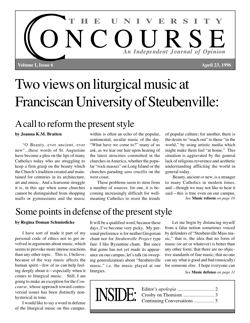Liturgical music at FUS: Some points in defense of the present style
by Regina Schmiedicke
I have sort of made it part of my personal code of ethics not to get involved in arguments about music, which seems to provoke more intense reactions than any other topic. This is, I believe, because of the way music affects the human spirit—few of us can help feeling deeply about it—especially when it comes to liturgical music. Still, I am going to make an exception for the Concourse, whose approach toward controversial issues has been distinctly non-hysterical in tone.
I would like to say a word in defense of the liturgical music on this campus. It will be a qualified word, because these days, I’ve become very picky. My personal preference is for neither Gregorian chant nor for Steubenville Project type fare: I like Byzantine chant. But since that genre has not yet made its appearance on our campus, let’s talk (in sweeping generalization) about “Steubenville music,” i.e. the music played at our liturgies.
Let me begin by distancing myself from a false notion sometimes voiced by defenders of “Steubenville Mass music,” that is, the idea that no form of music (or art or whatever) is better than any other form; that there are no objective standards of fine music; that no one can say what is good and bad (musically) for someone else. I hope everyone can see the falseness of this idea. There is a standard and we ignore it at the risk of sliding into musical mediocrity and indifferentism. Everybody in Chapel Music Ministry knows it, most musicians know it—anyone who has studied music can tell an inferior piece from a really fine one. Many people will admit that Mozart’s music is superior to Def Leppard’s, even if they do not personally care for Mozart. Artistic qualities of “goodness” or “poorness” transcend questions of taste and preference.
We should realize that critics of our present form of liturgical music are not saying: “Let’s have Bach and Mozart because I personally like their music better than Jim Cowan’s and Allison Waldrop’s.” They are arguing that our standard for liturgical music should be higher, regardless of what we or they happen to prefer. This distinction will have to be taken seriously if the discussion is to move ahead at all.
Also, before I praise the music here, I want to say that every once in a while a particular music group on campus might make a poor choice for, say, a Communion meditation song. And I have a private opinion that some of the songs we occasionally sing here (especially some in the brown hymnals) are semi-heretical and should not be used. For example, that admittedly moving song “In Remembrance of Me,” with its lyrical climax of “In remembrance of Me, don’t look above but in your heart for God…” seems to me an implicit slighting of our Father in heaven.
But I think there are many good things to be said for the music in general.
1) Contrary to its bad reputation among Catholic conservatives, the music coming out of the charismatic renewal (an admittedly broad spectrum) can and does foster reverence. I am not speaking of hand-clapping favorites like “Come n’go with me to that Land” or “What a mighty God we serve.” These songs have their place: I’ve enjoyed singing them around the campfire or before a talk at a youth conference. But I refer rather to songs like “To Him Who Sits on the Throne,” or “Psalm 150” (“Praise God in His Holy Temple”—whose chorus is often used as a Gospel “Alleluia” at Mass.) Most liturgical music at the typical American parish is not reverent at all, but flagrantly sentimental and self-serving. Steubenville music is, by comparison, a cut above the average and a huge improvement (e.g. contrast the lyrics of our “Press On” with those of “Whatsoever you do” from the brown hymnal.) It focuses the congregation on God, in worship, rather than on some self-congratulating “people of God.” This attitude of reverence is the first step and a major step in correct hymnology. It’s a good intermediate step towards Gregorian chant and other forms of “better music.”
2) Also, over the years, the music on campus has evolved towards some of these better forms. Witness the use of the chant “Agnus Dei,” which all the Steubenville congregation can sing, and which hardly any youth outside Steubenville would even recognize. In recent years the “Kyrie Eleison” and the “Sanctus” have been introduced. I am waiting for the day when the music ministry will include the “Pater Noster” as a regular feature, maybe even a “Credo.” I see a slow but regular growth towards traditional forms and solemnity. In other words, if you don’t like FUS liturgy music, wait around ten years. (Joke).
3) After experiencing four years of the lively, genuine worship here at FUS, a student probably will be able to appreciate something like a Bach Mass when he does encounter it. I know it helped me become more open to the classics and Gregorian chant. If it hadn’t been for “Ascribe to the Lord” I never could have appreciated Mozart’s Mass. The abyss between pop culture and the treasures of the Church is a wide one, and I think the Steubenville crowd do a good job trying to span it. Very few people are even trying to build a bridge at all these days.
4) Also, the campus music ministers do a fantastic job of reviving traditional songs. How many FUS students and alumni now know by memory the lyrics to such noble “oldies” as “Holy, Holy, Holy” and “Holy God, We Praise Thy Name,” thanks to our music ministry? And when the music ministry does these songs, it’s not some token “reverent music,” but a vigorous rendition of those tunes that leaves the freshmen in the congregation saying, “Man, what a cool song!”
5) Notwithstanding assertions to the contrary, not all of the “new music” is simply pop tunes with sacred lyrics. Witness “O Come Let Us Sing for Joy to the Lord,” by Robert Mason (Integrity Hosanna) or the Israelite folk style “Elohim Adonai” (John Flaherty, Steubenville), the strident “Glory, Hallelujah” (Word of God), or the jubilant “He is Exalted” (Twila Paris). Perhaps my own musical taste is betrayed in this choice of songs, but I have a feeling that some of these songs will endure the test of time and outlive the current liturgical fads.
Which brings me to one last point—another good thing about Franciscan University’s liturgical music: it is a musical testing ground for the new as well as a showcase of the old. I do not believe we could have the benefits of one without patiently enduring the other.
Regina Doman (class of ‘92) is a mother and freelance writer living in Steubenville with her husband, Andrew Schmiedicke, a student in the MA Theology program.


